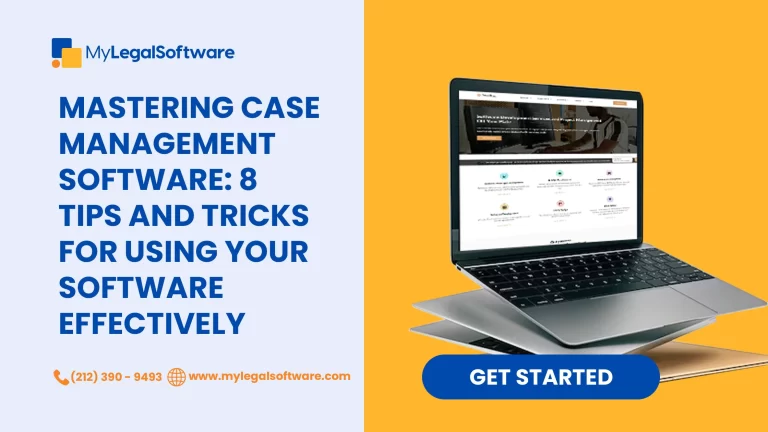Starting your own law firm can be exciting, but without a solid legal budget, it can also be a financial headache. Between office space, legal software, and hiring a team, the costs pile up quickly—and if you’re not careful, they can spiral out of control. But here’s the thing: budgeting doesn’t have to be overwhelming. With the right approach and smart tools like case management software, you can take charge of your finances, keep expenses in check, and build a firm that’s set up for long-term success. Let’s break it down step by step.
Step 1: Understanding Your Startup Costs
Before you can create a legal budget, you need to know what you’re paying for. Law firms have some unavoidable startup costs, including:
- Office space – Whether it’s a home office or leased space, you need a professional setting.
- Technology – Computers, printers, phones, and legal case management software.
- Bar dues & licensing fees – You can’t practice without them.
- Legal research tools – Platforms like Westlaw or LexisNexis help with case prep but come at a cost.
- Marketing & branding – A website, logo, and online ads help bring in clients.
- Insurance – Malpractice insurance is a must-have for protection.
How Much Should You Budget?
Startup costs for small firms range from $5,000 to $50,000, depending on location and practice area. However, you don’t need to pay for everything upfront. Some costs, like marketing and legal software, can be spread out over time.
Step 2: Managing Cash Flow Like a Pro
A great legal budget goes beyond simply cutting expenses—it’s about cash flow management. Cash flow is the money coming in versus the money going out. Even if you have paying clients, poor cash flow can leave you struggling to cover expenses.
Here’s how to keep your cash flow healthy:
Separate Business and Personal Finances
Open a business bank account to track income and expenses. Mixing personal and firm finances makes budgeting a nightmare.
Use Case Management Software
Modern case management software helps you track client payments, bill hours efficiently, and send automated invoices. This keeps revenue flowing and ensures you get paid on time.
Plan for Slow Months
Most firms experience seasonal ups and downs. Keep at least three months of expenses in reserve to handle slow periods.
Offer Multiple Payment Options
Make it easy for clients to pay by accepting credit cards, online payments, or installment plans. More payment options mean faster collections.
Step 3: Budgeting for Growth
Once you’ve covered startup costs and managed cash flow, it’s time to plan for long-term success.
Prioritize Revenue-Generating Expenses
Some expenses help your firm grow, while others drain your budget. Focus on:
- Marketing that works – Track ROI on ads and only invest in what brings clients.
- Case management software – It saves time, increases efficiency, and helps you scale.
- Outsourcing non-billable tasks – Hiring virtual assistants for admin work lets you focus on legal matters.
Track Every Dollar
A great legal budget isn’t about cutting costs—it’s about spending wisely. Review your finances monthly to see where your money goes. If something isn’t delivering value, cut it.
Reinvest in Your Firm
As your revenue grows, reinvest wisely. Hiring another attorney or upgrading software may seem expensive, but if it increases efficiency and brings in more business, it’s worth it.
Step 4: Choosing the Right Case Management Software
Not all case management software is the same. The best ones help you:
- Track expenses and bill clients easily
- Automate repetitive tasks to save time
- Manage documents and case files in one place
- Improve client communication
A great legal budget includes the right tech tools—and case management software is one of the smartest investments you can make. A good option is MyLegalSoftware. Try it today.
Step 5: Avoiding Common Budgeting Mistakes
Even the best attorneys make financial mistakes when starting out. Avoid these pitfalls:
- Underpricing your services – Don’t undervalue your time. Charge rates that reflect your expertise.
- Ignoring hidden costs – Office supplies, software updates, and bar fees add up. Account for them.
- Not tracking billable hours – Every minute counts. Use software, especially reliable ones like MyLegalSoftware, to record billable time.
- Overinvesting too soon – Start lean. You don’t need the biggest office or most expensive tools on day one.
Step 6: Budgeting for Team Growth and Employee Salaries
As your law firm grows, you may need to hire employees. This is a major financial commitment, so budgeting for salaries is crucial.
Decide Who to Hire First
Many solo attorneys start by hiring a paralegal or administrative assistant to handle routine tasks. This allows you to focus on billable legal work while reducing workload stress.
If your firm expands quickly, consider hiring:
- Associate attorneys – To handle more cases and increase firm revenue.
- Legal assistants – To manage paperwork and scheduling.
- Marketing professionals – To help generate leads and bring in new clients.
Factor in Employment Costs
When budgeting for staff, don’t just consider salaries. Include:
- Payroll taxes
- Employee benefits (health insurance, retirement plans)
- Software and training costs
Start with Contract or Part-Time Help
If you’re not ready for full-time employees, hiring freelancers or part-time staff is a cost-effective option. You get the help you need without the long-term financial commitment.
Step 7: Planning for Unexpected Expenses
No matter how carefully you budget, unexpected expenses happen. A sudden lawsuit, office repairs, or client disputes can put financial strain on your firm.
To prepare:
- Set aside an emergency fund with at least 3-6 months’ worth of expenses.
- Consider business insurance to cover unexpected losses.
- Review your budget quarterly to adjust for new costs.
A well-planned legal budget keeps your firm financially stable, even when surprises come your way.
Final Tip: Always track financial performance. The more data-driven your firm is, the easier it becomes to budget wisely and increase profitability.
Conclusion
Creating a legal budget doesn’t have to be stressful. With smart cash flow management, the right case management software, and careful planning, new law firms can thrive financially.
Need help managing your budget? MyLegalSoftware offers powerful tools to track expenses, invoice clients, and streamline law firm finances—all in one place.
Try it today at MyLegalSoftware.com.
Want to know how you can build a strong brand identity for your new law firm? Go here.
Frequently Asked Questions
What percentage of revenue should go to a law firm’s budget?
Ideally, 50% covers operating expenses, 25% goes to taxes, and 25% is profit. Adjust based on your firm’s needs.
How much should a new law firm budget for marketing?
New firms should spend 5-10% of revenue on marketing. Focus on high-ROI strategies like SEO, networking, and paid ads.
Why is case management software important for budgeting?
It helps track expenses, streamline billing, and ensure you don’t lose revenue due to missed invoices or poor time tracking.











